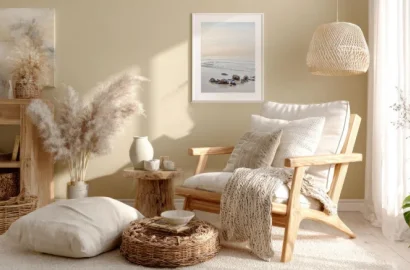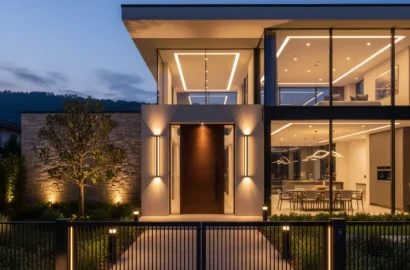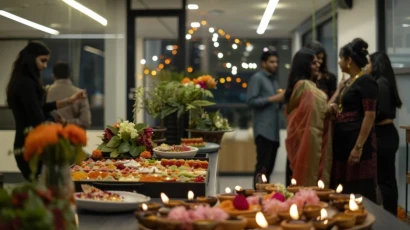Discover why enrolling in a formal interior design course could be your best move yet. Uncover key considerations for evaluating courses and explore the myriad career opportunities awaiting you upon graduation in 2025.
Whether you’re an aspiring interior designer eager to enhance your skills or someone contemplating a career transition into the field—learning interior design through a formal course can empower you to make your mark in this space. While self-teaching basics is an option, there exists a plethora of interior design courses designed to furnish you with practical expertise and a refined approach, ultimately increasing your chances of securing employment in the field.
In this blog, we delve into the reasons why investing in an interior design course can be a game-changer for you in 2025. Furthermore, we offer guidance on navigating the diverse array of interior design education options, ensuring you find the perfect fit for your aspirations and unveil the exciting career prospects that await skilled interior designers.
Contents:
- What are the benefits of pursuing an interior design course?
- How to choose the right interior design course?
- Career opportunities in interior design
1. What are the benefits of pursuing an interior design course?
Pursuing an interior design course can provide you with an edge over your peers in several ways. Let’s explore some of them.

i. Comprehensive Knowledge Coverage
A well-rounded curriculum is the backbone of any interior design course. A curriculum that strikes a balance between theoretical knowledge and practical application is ideal for the holistic development of learners and enables them to make a mark in the field.
Essential topics that an interior design course often covers include:
- Design Principles: This would include fundamentals such as balance, proportion, scale, rhythm, and harmony, that lay the groundwork for creating cohesive designs.
- Space Planning: Mastery of space planning techniques enables you to optimize the functionality and flow of interior spaces while adhering to building codes and regulations.
- Color: Delving into color theory, the psychology of color, and color schemes, can lend an understanding of the impact of color on mood, perception, and spatial perception.
- Materials and Finishes: Explores a wide range of materials, finishes, textiles, and furnishings, helping students learn their properties, applications, and implications on design.
- Software Proficiency: Proficiency in industry-standard software tools such as AutoCAD, SketchUp, Revit, and Adobe Creative Suite to help enhance your efficiency and effectiveness as a designer.
ii. Portfolio development
A robust interior design portfolio is your visual resume and a testament to your skills, creativity, and design sensibilities. Courses prioritize portfolio development, offering:
- Project-Based Assignments: Hands-on projects that challenge your creativity and allow you to demonstrate your design process, problem-solving skills, and aesthetic vision.
- Critique and Feedback: Constructive criticism and feedback from instructors and peers to refine your work, identify areas for improvement, and enhance your portfolio’s quality.
- Exhibition Opportunities: Your work is showcased in exhibitions, design competitions, or online platforms to gain exposure, recognition, and validation within the design community.
iii. Expert guidance
Expert guidance plays a pivotal role in shaping your educational experience and professional development. Most, if not all, of the interior design courses are taught by:
- Industry Practitioners: Mentors with extensive experience and a proven track record in the field bring real-world insights, best practices, and industry connections to the classroom.
- Experienced Academicians: Access to personalized mentorship, one-on-one consultations, and professional development opportunities with seasoned design educators enhances your learning experience and accelerates your growth.
iv. Peer-to-peer learning opportunities
Collaborative learning environments that make up a huge part of the learning in interior design courses foster creativity, critical thinking, and camaraderie among students. Such courses promote:
- Group Projects: Allowing you to collaborate with classmates on design projects, in turn gaining exposure to diverse perspectives, ideas, and approaches to problem-solving.
- Critique Sessions: Encouraging you to participate in peer critique sessions where you can offer feedback, receive insights, and learn from your peers’ experiences and perspectives.
v. Career support services
Transitioning from student to professional can be daunting, but comprehensive career support services can ease the process. Here’s what interior design courses offer in this regard:
- Job Placement Assistance: Access to job boards, career fairs, and networking events facilitating your job search and connecting you with potential employers.
- Resume and Portfolio Workshops: Guidance on resume writing, portfolio development, interview preparation, and networking strategies equipping you with the tools and confidence to pursue career opportunities.
vi. Facilities and resources
Access to state-of-the-art facilities, resources, and technology enriches your learning experience and supports your creative endeavors. Interior design courses provide access to the following resources:
- Design Studios: Well-equipped with ample space, natural light, and ergonomic furniture, these facilitate collaboration, creativity, and productivity.
- Computer Labs: Access to computers, software licenses, and technical support enables you to develop digital design skills and produce professional-quality presentations and renderings.
- Libraries and Resource Centers: Extensive libraries, digital databases, and resource centers offer access to research materials, design publications, and industry journals to inspire and inform your design process.
vii. Internship and job placement opportunities
Practical experience is invaluable for bridging the gap between academia and industry. Formal interior design courses recognize its importance and, hence, facilitate:
- Internship Programs: Opportunities to intern with design firms, architecture studios, or corporate design departments provide hands-on experience, mentorship, and networking opportunities.
- Industry Partnerships: Collaboration with industry partners, sponsors, and affiliates enhances your exposure to real-world projects, clients, and professional practices.
- Job Placement Assistance: Guidance on job search strategies, resume writing, interview preparation, and networking facilitates your transition into the workforce and positions you for career success.
viii. Industry connections
Networking is essential for building relationships, expanding your professional network, and accessing opportunities within the industry. Top interior design courses are often armed with certain affiliations to help with the same.
- Professional Associations: Membership in professional associations such as the American Society of Interior Designers (ASID), International Interior Design Association (IIDA), or National Council for Interior Design Qualification (NCIDQ) provides access to resources, events, and mentorship opportunities.
- Industry Organisations: Partnerships with industry organizations, trade shows, and conferences offer exposure to the latest trends, technologies, and best practices in interior design.
- Renowned Design Firms: Affiliation with renowned design firms, studios, or agencies provides access to internships, mentorship, and career advancement opportunities within the industry.

2. How to choose the right interior design course?
Before finalizing which interior design course to pursue, evaluate the following aspects to ensure it align with your needs and preferences.
i. Career Goals
What are your career aspirations in the field of interior design? Determine whether you envision yourself specializing in residential, commercial, hospitality, or sustainable design. Consider how the course curriculum and opportunities align with your career goals. For instance, if you aspire to design sustainable spaces, look for courses that offer coursework or specialisations in green design principles and practices.
ii. Learning Style and Requirements
Reflect on your preferred learning style. Consider whether you thrive in hands-on workshops, interactive lectures, or self-paced online modules. Assess how the course’s teaching methods, resources, and support services cater to your learning preferences. If you learn best through practical application and experimentation, prioritize courses that offer studio-based projects and experiential learning opportunities.
iii. Budget
Determine your budget for tuition fees and additional expenses. Calculate the total cost of education, including materials, transportation, and living expenses. Explore financial aid options such as scholarships, grants, or loans to make education more affordable. Compare the cost of different courses and weigh them against the potential return on investment in terms of career advancement and earning potential.
iv. Time Commitment and Schedule
Assess your availability and commitments. Evaluate your current workload, family responsibilities, and other commitments to determine how much time you can dedicate to your studies. Choose a course format and schedule that accommodates your lifestyle and allows you to balance your priorities effectively. Whether you prefer full-time, part-time, evening, weekend, or online options, ensure they align with your availability and learning preferences.
v. Prerequisites and Admission Requirements
Review the prerequisites and admission requirements. Check whether you meet the eligibility criteria for enrollment, including academic qualifications, portfolio submission guidelines, and any additional requirements. Address any gaps in prerequisites by acquiring the necessary skills or credentials before applying to the course.
vi. Location and Accessibility
Consider the location of the institution or campus. Evaluate the geographical location, commuting options, and accessibility for international students or individuals residing in remote areas. Determine whether you prefer studying in a vibrant urban setting, a suburban campus, or a virtual learning environment. Accessibility to campus facilities, resources, and industry opportunities can influence your overall learning experience.
vii. Specializations
Explore the specializations, electives, or concentrations offered within the course. Tailor your education to specific areas of interest or career paths by selecting courses that align with your passions and professional goals. Whether you’re interested in residential design, commercial interiors, hospitality spaces, or niche specialties such as healthcare or retail design, choose a course that offers relevant coursework and opportunities for specialization.
viii. Flexibility in Course Format
The flexibility of course formats and schedules accommodates diverse learning styles, commitments, and preferences. Consider options such as:
- Full-Time, Part-Time, and Online Courses: Choose a course format that aligns with your availability, lifestyle, and preferred learning environment, whether you prefer immersive on-campus experiences or flexible online learning.
- Evening and Weekend Classes: Evening and weekend classes cater to working professionals or individuals with busy schedules, allowing you to pursue your passion for interior design without sacrificing your other commitments.
ix. Alumni success, reputation and rankings
The reputation and track record of the institution or program can offer insights into the quality, credibility, and outcomes of the course. Consider researching about:
- Alumni Success Stories: Research the career trajectories, accomplishments, and testimonials of alumni to gauge the impact and effectiveness of the course in launching successful careers.
- Institutional Reputation: Consider factors such as accreditation, faculty credentials, industry recognition, and institutional rankings to assess the credibility and prestige of the course.
- Industry Recognition: Programs recognized by industry leaders, professional associations, or accreditation bodies demonstrate adherence to high standards of excellence and relevance within the field.

Career opportunities in interior design
Upon completing an interior design course, you can explore a variety of career opportunities across different sectors and specialties, including but not limited to our list below. For a detailed overview, consider reading this in-depth guide to Interior Design jobs
i. Interior Designer
Description: Interior designers conceptualize and create functional, aesthetically pleasing interior spaces for residential, commercial, or institutional clients.
Responsibilities: They collaborate with clients to understand their needs, preferences, and budget constraints, develop design concepts, produce detailed drawings and specifications, select materials and furnishings, and oversee the implementation of the design.
ii. Interior Decorator
Description: Interior decorators focus on selecting and arranging furniture, accessories, and décor elements to enhance the look and feel of interior spaces.
Responsibilities: They work with clients to define their style preferences and design objectives, source and procure furnishings and accessories, coordinate installations, and curate cohesive design schemes that reflect the client’s personality and lifestyle.
To know how this role is different from that of an interior designer, consider reading this blog: Interior Decoration vs. Interior Design
iii. Architectural Designer
Description: Architectural designers collaborate with architects and engineers to integrate interior design concepts into architectural projects, ensuring spatial functionality, aesthetic appeal, and regulatory compliance.
Responsibilities: They contribute to the design development process, develop interior layouts, coordinate finishes and materials, and liaise with consultants and contractors to ensure seamless integration of interior design and architectural elements.
iv. Space Planner
Description: Space planners analyze and optimize spatial layouts to maximize efficiency and functionality in residential or commercial environments, considering factors such as traffic flow, spatial organization, and ergonomic design principles.
Responsibilities: They assess spatial requirements, develop space plans and furniture layouts, recommend design solutions to improve workflow and productivity, and create environments that enhance the user experience and support business objectives.
v. Furniture Designer
Description: Furniture designers create custom furniture pieces or design furniture collections for manufacturers or retailers, blending aesthetic appeal with functionality, ergonomics, and sustainability.
Responsibilities: They conceptualize designs, develop prototypes, select materials and finishes, collaborate with manufacturers or craftsmen to produce furniture pieces, and ensure quality control and compliance with industry standards.
vi. Lighting Designer
Description: Lighting designers plan and implement lighting schemes to enhance ambiance, mood, and functionality in interior spaces, integrating natural and artificial lighting solutions to create dynamic and visually appealing environments.
Responsibilities: They assess lighting requirements, develop lighting concepts and layouts, specify fixtures and controls, collaborate with architects and electrical engineers, and conduct lighting simulations to achieve desired lighting effects and energy efficiency.
vii. Kitchen and Bath Designer
Description: Kitchen and bath designers specialize in the design and renovation of kitchens and bathrooms, focusing on layout optimization, fixture selection, material coordination, and aesthetic enhancement.
Responsibilities: They work closely with clients to understand their lifestyle needs and design preferences, develop space plans, select cabinetry, countertops, fixtures, and finishes, and coordinate with contractors and vendors to ensure successful project execution.
viii. Retail Store Designer
Description: Retail store designers create immersive environments, displays, and branding elements to attract customers and enhance the shopping experience, integrating retail merchandising principles with interior design concepts.
Responsibilities: They collaborate with retailers to define brand identity and customer demographics, develop store layouts and floor plans, design fixtures and displays, and create visually compelling environments that drive foot traffic and sales.
ix. Set Designer
Description: Set designers create immersive environments for film, television, theatre, or events, translating scripts or concepts into tangible sets that support storytelling and evoke emotional responses.
Responsibilities: Their work requires them to work closely with directors, producers, and production designers to interpret creative visions, research historical and thematic references, develop set designs and construction drawings, oversee set construction and installation, and coordinate with scenic artists and craftsmen to bring designs to life.
x. Exhibition Designer
Description: Exhibition designers create immersive exhibits, displays, and installations for museums, galleries, trade shows, or events, engaging and educating audiences through spatial storytelling and interactive experiences.
Responsibilities: They work alongside curators, educators, and content experts to develop exhibition concepts and themes, create floor plans and exhibit layouts, design environmental graphics and signage, specify multimedia and interactive elements, and oversee installation and de-installation processes.
4. What’s next?
In this article, we’ve covered the benefits of pursuing an interior design course and laid out the numerous and varied career options you can choose from in the field.
If you’re considering learning about interior design and launching an exciting new career in the space, check out AND’s Interior Design Courses which come with ample hands-on learning opportunities, a comprehensive curriculum, and dedicated placement support to help you launch a lucrative career.
For further assistance, refer to the following resources:
- Watch this session by Snehanshu Mukherjee, Founding Partner at T.E.A.M and Mansi Almadi, an Interior Designer at Studio Lotus
- Talk to a course advisor to discuss how you can transform your career with one of our courses.
- Check out our Interior Design courses – all courses are taught through live, interactive classes by industry experts.
- Take advantage of our scholarship and funding options to overcome any financial hurdle on the path of your career transformation.
Note: All information and/or data from external sources is believed to be accurate as of the date of publication.









